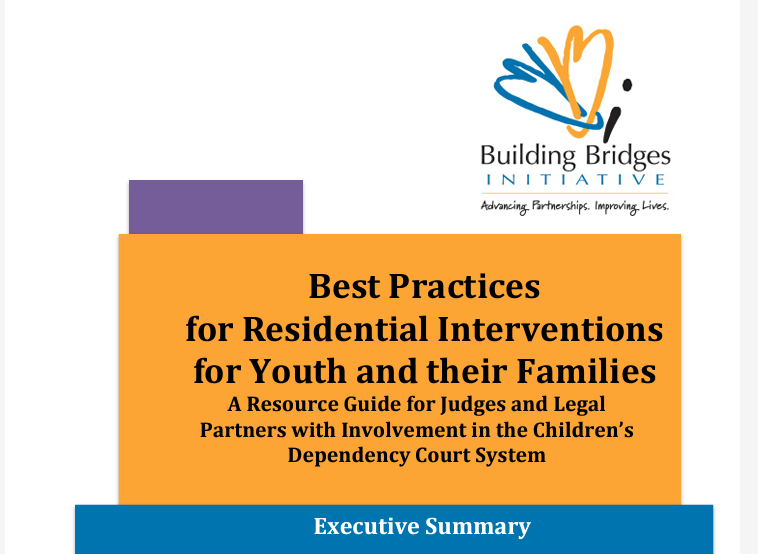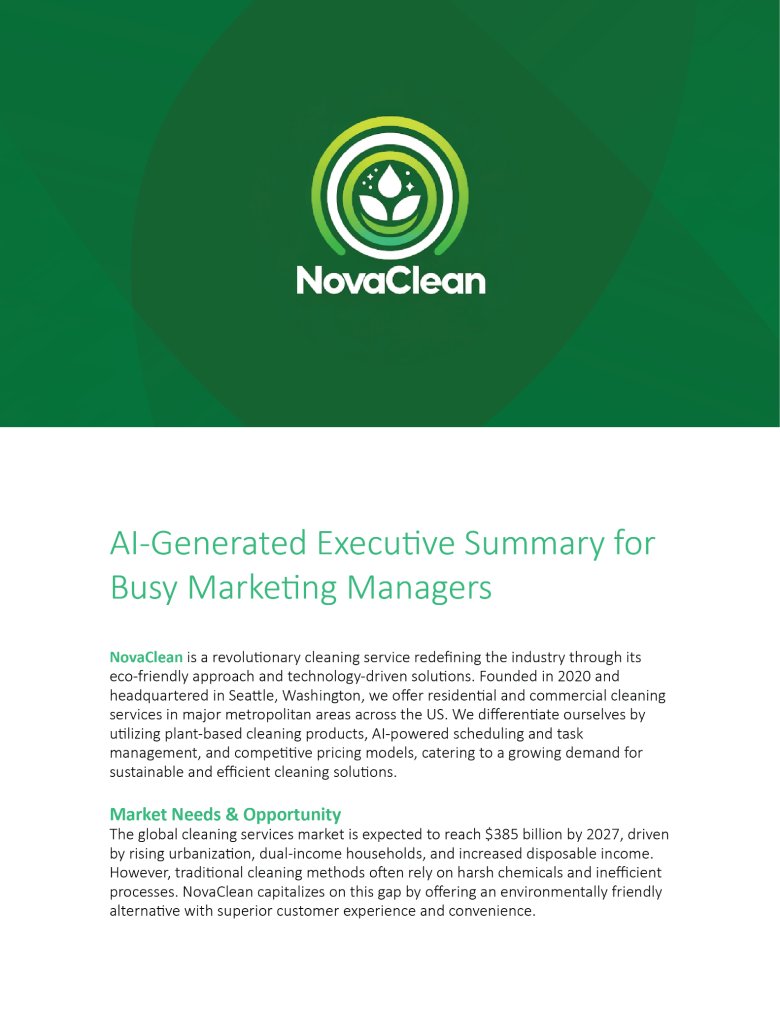How to Write an Effective Executive Summary: Prompts and Templates
As an experienced marketing expert, you’re likely familiar with the idea of an executive summary. You know that this content is often your first chance to pull people into your ideas and wow them. Of course, writing an executive summary is harder than it sounds.
Media Shower is here to help! In this guide, you’ll discover our AI-powered Executive Summary Generator, as well as FAQs and best practices that will deliver summaries that sizzle.
Executive Summary Generator
Just answer a few questions, and we’ll generate a complete marketing executive summary — instantly and free.
AI Prompts for Executive Summaries
Once you’ve drafted your marketing executive summary above, use these prompts to polish and perfect it.
- To improve tone and style: Enhance the tone of the executive summary to sound more authoritative and confident.
- To condense content: Use AI to shorten the executive summary while retaining all essential information within a 300-word limit.
- To use industry-specific language: Tailor the language of the executive summary to resonate with professionals in the technology sector.
- To emphasize key points: Identify the three most critical aspects of the business/project and ensure they are highlighted in the summary.
- To reorganize for impact: Restructure the executive summary, placing the unique value proposition at the beginning for maximum effect.
- To clarify the language: Articulate the audience’s pain point with greater emotional appeal to evoke empathy and understanding.
- To highlight success metrics: Incorporate key performance indicators to showcase achievements and growth.
- To emphasize market research: Add a section to outline recent market research insights and how they inform our strategy.
- To spotlight your competitive advantage: Clarify how this project differentiates itself from competitors, focusing on specific strengths and advantages.
- To establish future goals: Include a forward-looking section detailing the project’s long-term objectives and expansion plans.
Examples of Effective Executive Summaries
Here are examples of executive summaries to help you unlock the secrets of concise and compelling communication for your projects:
Executive Summary by Building Bridges Initiative
 Image Source: Sample.net
Image Source: Sample.net
This executive summary is effective for several reasons:
- Clear and concise language: It uses straightforward language that is easy to understand for a broad audience, including judges, legal partners, and professionals working with youth and families.
- Compelling introduction: It starts with a strong statistic about the prevalence of residential interventions for children in foster care, highlighting the need for best practices.
- Emphasis on key points: It uses bullet points and clear headings to present the critical components of safe, quality, and effective residential programs.
- Actionable questions for courts: It provides specific questions that judges and legal partners should ask to assess the quality of residential programs.
Food Chain Intelligence Executive Summary
 Image Source: Sample.net
Image Source: Sample.net
This executive summary by Food Chain Intelligence investigates best practices for reducing greenhouse gas emissions in food distribution systems. Five categories of initiatives are explored: farmer-led, consumer-led, retailer-led, global manufacturer-led, logistics-led, and government-led.
- Clear and concise: It provides a high-level overview of the report’s objectives, findings, and recommendations.
- Calls to action: It encourages collaboration and highlights opportunities for further investigation.
Zoom Executive Summary
 Image Source: Sample.net
Image Source: Sample.net
This executive summary by Zoom effectively captures the attention of its target audience by clearly outlining the problem, showcasing the value proposition, and providing compelling evidence. It is concise, informative, and actionable, leaving a positive impression on potential customers.
- Well-structured: The summary is well-structured with headings, bullet points, and concise language.
- Design: Not every executive summary uses visuals, but this one does and does so very well. It is visually appealing with images and a logo.
- Accessible language: It avoids technical jargon, focuses on user benefits, and uses statistics to add credibility.
AI-Generated Executive Summary for Busy Marketing Managers
 10 Best Practices for Executive Summaries
10 Best Practices for Executive Summaries
- Keep it concise: Summarize key points succinctly, aiming for a length of about 10% of the original text.
- Highlight your USPs: Clearly communicate the unique value your business offers to customers.
- Know your audience: Tailor the summary to resonate with the specific interests and needs of your target audience.
- Focus on results: Emphasize achievements, metrics, and success stories to showcase your business’s impact.
- Include visual elements: Incorporate charts or graphs to present data and make the summary more engaging.
- Address pain points: Identify and address the primary challenges your business solves for its customers.
- Use a logical structure: Organize the content coherently, starting with a compelling introduction and ending with key takeaways.
- Avoid jargon: Use clear and accessible language that everyone can understand, regardless of their industry knowledge.
- Review and edit: Ensure the summary is error-free and polished before sharing it with stakeholders.
- Update regularly: Keep the executive summary current to reflect the latest developments and accomplishments.

10 Frequently Asked Questions (FAQs) About Executive Summaries
How long should an executive summary be to achieve optimal effectiveness?
Executive summaries are typically around 10% of the length of the full document. For instance, if the complete document is 20 pages long, the executive summary should ideally be about 1-2 pages.
What is the purpose of an executive summary?
The primary purpose of an executive summary is to provide decision-makers with a clear and quick understanding of the document's main points. It allows busy executives to grasp the significance of the content and make informed decisions without delving into the full report.
What should I include in an executive summary to make it stand out?
Focus on your unique value proposition, achievements, and how they address your audience’s pain points.
What's the difference between an executive summary and an abstract?
While both provide summaries, an executive summary is specific to business plans and reports, whereas an abstract is more commonly used in academic or research contexts.
Can I use an executive summary for different purposes, like marketing materials or investor pitches?
Absolutely! In fact, it's good practice to repurpose your executive summary for various scenarios to deliver a compelling and consistent message.
Is it necessary to include financial data in the executive summary, and if so, which financial metrics should be prioritized?
This depends on the document and its intended audience. For example, if you are targeting shareholders or trying to attract investors, including relevant financial data can strengthen your executive summary. Focus on key metrics like revenue, profitability, and growth projections to provide a clear financial snapshot.
Should an executive summary be written before or after the full document?
It's generally advisable to write the executive summary after completing the full document. This way, you'll have a comprehensive understanding of the content, making it easier to select and summarize the most critical points.
Should I provide citations in the executive summary?
In general, executive summaries do not require detailed citations. However, if you include specific data or references, you can provide a brief source attribution without overwhelming the summary with citations. If the reader needs more details, they can refer to the full document.
Can I include visuals like charts and graphs in the executive summary?
Visuals can be impactful in conveying complex data quickly. However, ensure that visuals are easy to understand and complement the text. If you include visuals, provide brief explanations to ensure they are meaningful even without the full context.
What is the best way to open an executive summary and grab the reader's attention?
Start with a concise and compelling opening statement that introduces the problem, opportunity, or main objective of the document. Focus on presenting a clear reason for why the content matters to the reader.
10 Protips for Executive Summaries
- Clarity is key. Use straightforward language and avoid jargon to ensure easy comprehension.
- Know your audience. Tailor the content to resonate with the interests and needs of your specific stakeholders.
- Lead with impact. Start with a compelling introduction to grab attention from the start.
- Highlight value propositions. Clearly articulate the unique value your business brings to the table.
- Focus on results. Emphasize achievements and measurable outcomes to demonstrate success.
- Keep it concise. Summarize key points without overwhelming the reader with excessive details.
- Visualize data. Incorporate charts or graphs to present complex data in an accessible format.
- Edit ruthlessly. Ensure your executive summary is error-free and polished before sharing it.
- Stay current. Regularly update your summary to reflect the latest developments and milestones.
- Get input. Seek feedback from colleagues to refine and improve your executive summary.
The Media Shower platform lets you draft great executive summaries using our AI assistants, then send to our expert creative team to make them into marketing magic. Click for a free trial.


